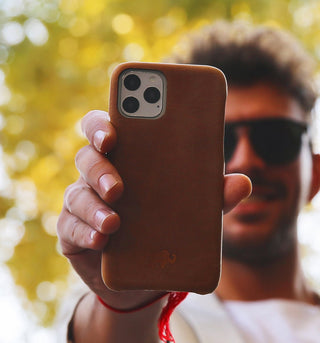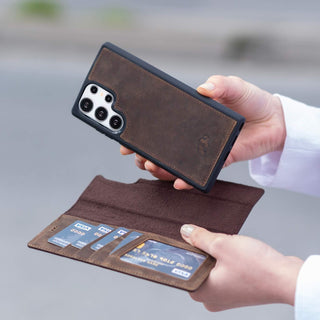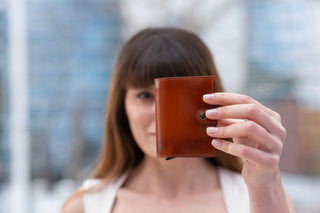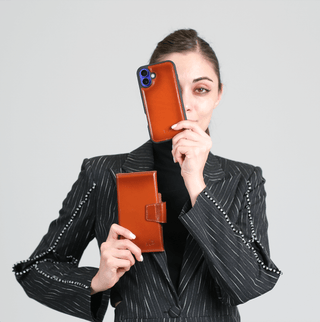At BlackBrook, we bench-tested iPhone 17 cases across MagSafe and Qi2 to see how case design, not just wattage, actually changes your charge time.
Wireless charging speed isn’t only determined by wattage; it’s also about alignment, rigidity, and heat management. As iPhone 17 embraces both MagSafe and Qi2 standards, we wanted to understand how case design affects real-world charging. Through benchmark-style testing, we explored what keeps charge times short, coils cool, and MagSafe reliability high.
At BlackBrook, we’ve spent years crafting MagSafe-ready leather cases that deliver slim protection and uncompromised charging performance. This guide is based on our in-house benchmarks and aims to help you understand what really affects wireless charging efficiency, and how to test your own setup at home.
Benchmark Principles
No two charging sessions are identical. Charge times fluctuate based on temperature, battery health, background activity, and adapter quality. That’s why we don’t claim to be faster than Apple’s standard. Instead, our focus is to identify which case attributes preserve, rather than restrict, MagSafe and Qi2 charging performance.
Consistency matters more than peak speed. We repeated every run under controlled indoor conditions, ensuring results reflect real-world behaviour, not lab tricks.
Test Setup & Methodology
We tested across the iPhone 17, 17 Pro, and 17 Pro Max, each running the latest iOS. Chargers included:
-
Power adapters: 20W+ USB-C PD chargers with E-marked cables
-
Room temperature: 22–24°C
-
Test conditions: Airplane mode on, display off, charging from ~5% battery
Each test was repeated three times to log times to 50%, 80%, and 100%, as well as surface temperature near the coil. Between runs, phones were cooled back to room temperature.
What Typically Affects Charge Time (Biggest to Smallest)
These facts determine your MagSafe/Qi2 charge time, in order of largest to smallest impact.

1. Alignment & Ring Precision
A perfectly embedded magnet ring aligns the charging coil automatically. Adhesive add-ons, however, often drift over time, forcing users to “hunt for the spot.” Misalignment can lead to comparatively slower charging.
2. Backplate Structure
A thin, rigid backplate keeps the coil flat on the puck, ensuring consistent contact. Softer or padded backs add distance, reducing effective power and slowing charge.
3. Heat Management
Wireless charging generates heat. Overly thick or closed cases trap it, triggering thermal throttling, especially above 80%. A firm yet breathable back helps sustain speed through the final stretch.
4. Accessories & Attachments
Snap-on wallets or stacked cards can cause visible slowdowns. For predictable results, detach wallets before charging and keep folio covers open.
5. Adapter & Cable Quality
Not all adapters are equal. Low-quality cables or bricks often cap output, limiting 15W charging to below 10W.
Aligning, structuring, heating, attaching, and powering are the five factors that can be nailed to make the charging fast, stable, and predictable.
Results by Charger Type (What to Expect)
Charging in real-life scenarios also depends on the condition of the hardware; here’s how popular MagSafe-compatible cases perform with chargers.
MagSafe 15W Puck
The most consistent and repeatable performer. Embedded magnet rings align instantly.. The difference is most noticeable during the “snap and start” phase; firm, rigid backs connect faster.
Qi2 15W Stand
Qi2 charging delivers similar times when alignment is accurate. Rigid-backed cases maintain contact even through taps or bumps, while soft or flexible shells show slight inconsistencies.
MagSafe / Qi2 Car Chargers
Vibration exposes weak magnets quickly. Rigid-core cases like the Arden Fully Wrapped Leather Case maintained stable contact, even on rougher roads. Expect small slowdowns versus desk chargers due to airflow and motion.
Legacy Qi (7.5W) Pads
These are far less forgiving. Even a millimetre of extra thickness stretches the total charge time. For best performance, ensure perfect centering and remove any wallets or accessories.
A case made of rigid material and slim enough to fit a 15W puck or Qi2 stand is recommended to ensure the highest consistency of the speed; car mounts and older Qi will never keep up.
Case Style Impact (What Helps, What Hurts)

The case type alters the consistency as well as the speed at which you charge your phone. These are some helpful points to keep in mind while making your choice:
Slim Leather MagSafe Cases
It performs best when the magnet ring is embedded and the backplate is rigid. The leather surface also helps prevent sliding during one-hand detachments, maintaining alignment integrity.
Hybrid Leather Wraps (Rigid Core)
Offer a balanced blend of structure, thinness, and precision. These usually test closest to bare-phone performance in our benchmarks.
Detachable Wallets & Folios
Always charge with the inner shell only. Overstuffed card slots or closed covers create air gaps and heat retention.
Snap-On Wallet Combos
Practical for carrying, not ideal for charging. Remove them during sessions to prevent slow starts or overheating.
Keep it plain: Charge with built-in ring cases, which are hardback, and detach your wallet for better speed and alignment.
Thermal Behaviour & Throttling
Heat is the enemy of fast wireless charging. As the temperature rises, the iPhone automatically reduces power intake to prevent battery wear. Cases with thin, rigid leather backs and microfiber linings dissipate heat efficiently, sustaining higher speeds longer.
When using a wireless charging iPhone 17 case, ensure there’s enough airflow around the coil, especially if you charge overnight.
At-Home Benchmark Protocol
Want to check your case? Here’s a simple, five-minute routine:
-
Cool your phone to room temperature; close all apps.
-
Place it on a MagSafe puck and start charging from ~5% battery.
-
Note the time to reach 50% and 80%; feel the surface for excess warmth.
-
Repeat with your wallet detached, then with the case off for comparison.
-
Re-run using your Qi2 stand, compare results.
The smaller the difference between cased vs. bare-phone times, the more optimized your case geometry is.
Troubleshooting Slow Charge Times
In case your MagSafe or Qi2 devices are not charging as fast as they should, perform these troubleshooting solutions first before doubting the charger.
-
Clean the charger pad and case back; oil or dust can cause micro-slippage.
-
Use certified 20W+ PD chargers and cables.
-
Remove wallets and open folio covers during charging.
-
Re-seat your phone if you need to “hunt for the spot.”
-
If your phone feels unusually hot, pause charging; heat always slows things down.
Once these checks have been performed, the charging should be back to normal. Otherwise, try another phone to determine whether the issue is with the charger or the device.
FAQs
Why does charging slow after 80%?
Thermal management reduces power to protect the battery, normal behaviour.
Do leather cases block MagSafe or Qi2 power?
No, not when the magnet ring is embedded and the backplate is thin.
Is Qi2 as fast as MagSafe?
Yes, both reach up to 15W when alignment and case geometry are correct.
Do wallets affect charging?
Yes. Snap-on wallets should always be detached for optimal performance.
What’s more critical, magnet strength or case thickness?
Both matter, but precise magnet alignment and rigid backing have the biggest real-world impact.
Benchmark-Proven MagSafe, Shop Now
Keep your charge times consistent and your desk clean. Choose a BlackBrook iPhone 17 case with an embedded ring, thin, rigid structure, and heat-smart leather design. Whether you use MagSafe or Qi2, our cases maintain the alignment, airflow, and durability you can trust, no hunting, no throttling surprises.











